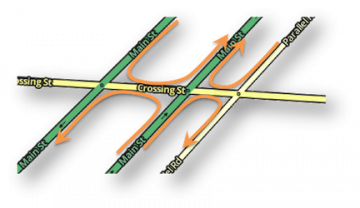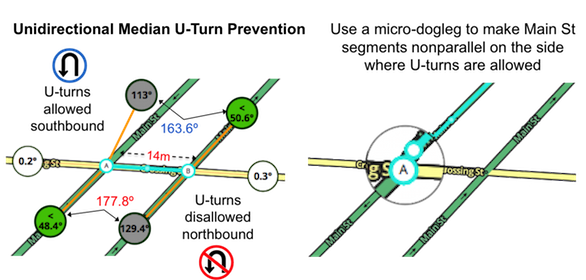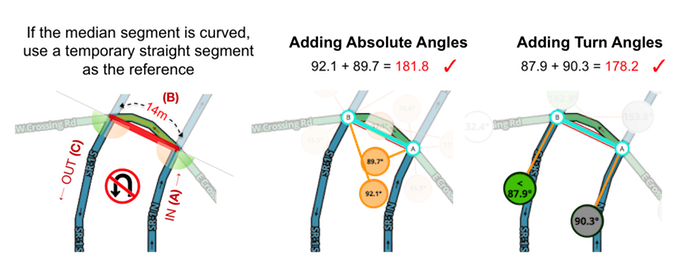m (PesachZ moved page User:PesachZ/Avoiding Uturns to User:TheLastTaterTot/Avoiding Uturns: merging histories) |
m (Undo revision 120209 by PesachZ to restore current version after history merge) |
||
| Line 1: | Line 1: | ||
=== {{@| | === {{@|Controlling U-turns}} === | ||
{{anchor|Avoiding U turns|Avoiding U turns in box and partial box intersections}} | {{anchor|Avoiding U turns|Avoiding U turns in box and partial box intersections}} | ||
{{Mbox|type=forum|text=For the latest discussion on this section please visit [http://www.waze.com/forum/viewtopic.php?t=108731 | {{hatnote|This article discusses double turn U-turns, for a standard one or two segment U-turn adjust the [[Interface_guide#Junction_Arrows|junction arrows]].}} | ||
{{Mbox|type=forum|style = background: #cadceb;|text=For the latest discussion on this section please visit the wiki forum thread [http://www.waze.com/forum/viewtopic.php?t=108731 <nowiki>[Page Update] Intersections / U-turns under 15m</nowiki>].}} | |||
[[File:U-turn_Roads.png||360px|right]] | |||
The Waze routing algorithm sets a [[Routing penalties#Road_configurations|penalty]] for some double-left or double-right turns. This can prevent U-turns at H or # style intersections on divided and parallel roads. This means that, even if both of the turns that make up the U-turn are allowed, the combination of the two turns might be prevented. | |||
If one of the two turns making up the U-turn is restricted or impossible, disallow that turn. The U-turn will then not be routed, and the following penalty does not matter. | |||
==== {{@|Preventing median U-turns}} ==== | ==== {{@|Preventing median U-turns}} ==== | ||
An extremely large U-turn penalty is set for a double-left or double-right turn when '''''all three''''' of the conditions below are met: | |||
# The U-turn | # '''Three segments''': The U-turn is a reversal of driving direction through three segments: <br>an incoming segment (A), a single median segment (B) and an outgoing segment (C). | ||
# | # '''Short median''': The median segment (B) is shorter than {{:Routing_penalties/U-turn_minimum}}.<br>''As a safety margin, leave a 1 m buffer zone by using {{:Routing_penalties/U-turn_minimum|less}} or less.'' | ||
# | # '''In/out parallelism''': The in and out segments (A and C) are [[#Checking for parallel incoming and outgoing segments|within ±5° of parallel]] to each other. | ||
<br> | <br> | ||
{{Mbox|type=important|text=It is possible for this method to fail to prevent a U-turn when it is the first segment of a route or reroute. If you observe this method to fail when it is implemented properly, please report it in [http://www.waze.com/forum/viewtopic.php?p=994385#p994385 this forum thread]}} | {{Mbox|type=important|text=It is possible for this method to fail to prevent a U-turn when it is the first segment of a route or reroute. If you observe this method to fail when it is implemented properly, please report it in [http://www.waze.com/forum/viewtopic.php?p=994385#p994385 this forum thread]}} | ||
| Line 18: | Line 21: | ||
==== {{@|Allowing median U-turns}} ==== | ==== {{@|Allowing median U-turns}} ==== | ||
To allow a double-left or double-right turn through | To allow a double-left or double-right turn through the median segment, break any one of the [[#Preventing median U-turns|above conditions]]. For example: | ||
* To allow median U-turns in both directions, break condition #2 by making | * To allow median U-turns in both directions, break condition #2 by making the median segment (B) {{:Routing_penalties/U-turn_minimum|greater}} ''or longer'' | ||
* To allow a U-turn from only one direction, first set up U-turn prevention for both directions. | * To allow a U-turn from only one direction, first set up U-turn prevention for both directions. Break condition #3 on the side where U-turns are allowed. Increase or decrease the angles so that the in and out segments (A and C) are [[#Checking for parallel incoming and outgoing segments|not parallel]]. A [[Glossary#mDL|micro-dogleg]] can be used to change the angle without changing the appearance of segment. | ||
[[File:U-turn selective Uturn prevention.png|center]] | |||
<br> | <br> | ||
==== {{@|Checking for parallel incoming and outgoing segments}} ==== | ==== {{@|Checking for parallel incoming and outgoing segments}} ==== | ||
Condition #3 for U-turn prevention requires the | Condition #3 for U-turn prevention requires that the in and out segments (A and C) are within ±5º of parallel to each other. This is checked by using a ''straight'' median segment as the reference and the [[Scripts#WME_Junction_Angle_info|Junction Angle Info]] (JAI) browser extension to measure angles. JAI may be set for absolute or [[Interactive_junction_instruction_algorithm#Turn_angle|turn angles]]; using either is OK. | ||
If segment | ===== {{@|Straight median segments}} ===== | ||
If the median segment is straight, sum the two angles making up the U-turn: | |||
:# The angle between the incoming and median segments (between A and B) | |||
:# The angle between the median and outgoing segments (between B and C) | |||
The in and out segments (A and C) are considered parallel if the sum is {{font color|red|between 175º and 185º}}. | |||
<br> | <br> | ||
[[File:U-turn_Parallel_Check_Straight.png| | {| style="border: 0px;text-align: center; line-height: 1; font-size: small;" | ||
|- | |||
| [[File:U-turn_Parallel_Check_Straight.png|680px]] | |||
|- | |||
| style="padding-bottom: 20px;" | The 14m median segment in the examples above satisfies condition #2 for U-turn prevention. | |||
|} | |||
If segment B has geometry nodes it is not straight | ===== {{@|Curved median segments}} ===== | ||
If the median segment (B) has been shaped with geometry nodes, it is not straight and cannot be used for determining parallelism. Instead, draw a straight segment connected at the same in and out junctions (where in-segment (A) junctions with the median segment (B) and where the median segment (B) junctions with the out-segment (C)). Check the angles using this new straight segment, and delete the new segment afterwards. | |||
<br> | <br> | ||
[[File:U-turn_Parallel_Check_Curved.png]] | [[File:U-turn_Parallel_Check_Curved.png||680px]] | ||
<br> | <br> | ||
{{mbox|type=protection|text=Be sure the [[Editing_permissions#Locked_junction|junctions are not locked]] above your rank. Otherwise, drawing a new temporary segment connected to locked junctions may produce a save error even if it is deleted prior to saving. | |||
{{Expand| | |||
# Disable the [[Map_Editor_Interface_and_Controls#Settings_Tab|WME setting]] "Draw new roads with all turns allowed" before drawing the new segment. | |||
# Draw the new segment disconnected from any other segment, then drag the end nodes to connect to the junctions. | |||
|workaround options when segment(s) connected to either junction node are locked above your rank. | |||
|nt=yes}}}} | |||
<includeonly>Please see the [[Routing penalties/Controlling U-turns#Additional examples|Controlling U-turns]] article for more advanced details, and additional examples.</includeonly><noinclude> | |||
==== {{@| | ==== {{@|Additional examples}} ==== | ||
<div style="font-size:smaller"> | |||
{| class="wikitable" cellpadding=2 style="width: 100%; text-align: left;" | |||
! style="width: 247px" | Example | |||
! style="width: 120px" | Tip | |||
! Details | |||
|- style="background-color: #fff;" | |||
| [[File:U-turn_example_2mediansegs-bdp.png|243px]] | |||
| Cutting a median segment into two may have unintended consequences | |||
| U-turns are legal at this intersection. Even though U-turn prevention will ''not'' be triggered here, Waze will rarely route a U-turn at this intersection. When the railroad was junctioned with the median segment, it cut a single median into two. The two-segment discontinuity between divided roads of Major Blvd can trigger a lower penalty mechanism designed to discourage detours off the main road (see [[Detour_Prevention_Mechanisms/USA#Big_Detours|Big Detour Prevention]], BDP). | |||
|- style="background-color: #fff;" | |||
| [[File:U-turn_example_2mediansegs-allowed.png|243px]] | |||
| Cutting a median segment into two may have unintended consequences | |||
| U-turns are not legal at this intersection, but Waze may route a U-turn here anyway. Cutting the median breaks condition #1, so U-turn prevention will not trigger. Furthermore, BDP might not trigger here if all of its criteria are not met. | |||
|- style="background-color: #fff;" | |||
| [[File:U-turn_example_curvedU.png|243px]] | |||
| A median segment longer than {{:Routing penalties/U-turn minimum}} will always allow a U-turn | |||
| While condition #3 requires a straight segment for determining parallel in and out segments, condition #2 is the measure of the length of the median segment itself. Be careful when the space between the divided road is small. Ensure the U-turn segment is longer than {{:Routing penalties/U-turn minimum}} by adjusting geometry. A median segment of any shape can trigger a U-turn penalty between parallel roads if it is not long enough. | |||
|- style="background-color: #fff;" | |||
| [[File:U-turn_example_parkinglot.png|243px]] | |||
| To ensure proper routing between two closely spaced parallel roads, connect the two with a segment {{:Routing penalties/U-turn minimum|greater}} or longer | |||
| U-turn prevention triggers for both double-left and double-right turns over any road type. If the three conditions for median U-turn prevention are met, a large penalty will be applied, irrespective of whether the turn is onto the same road in the opposite direction or onto a completely different road. Both double-left and double-right turns can be penalized, regardless of country, and can occur for one way or two way segments. | |||
|} | |||
</div> | |||
</noinclude> | |||
Revision as of 17:19, 30 September 2015
Controlling U-turns 
| For the latest discussion on this section please visit the wiki forum thread [Page Update] Intersections / U-turns under 15m. |

The Waze routing algorithm sets a penalty for some double-left or double-right turns. This can prevent U-turns at H or # style intersections on divided and parallel roads. This means that, even if both of the turns that make up the U-turn are allowed, the combination of the two turns might be prevented.
If one of the two turns making up the U-turn is restricted or impossible, disallow that turn. The U-turn will then not be routed, and the following penalty does not matter.
Preventing median U-turns 
An extremely large U-turn penalty is set for a double-left or double-right turn when all three of the conditions below are met:
- Three segments: The U-turn is a reversal of driving direction through three segments:
an incoming segment (A), a single median segment (B) and an outgoing segment (C). - Short median: The median segment (B) is shorter than 52.49 ft (16 m).
As a safety margin, leave a 1 m buffer zone by using 45.93 ft (14 m) or less. - In/out parallelism: The in and out segments (A and C) are within ±5° of parallel to each other.
| It is possible for this method to fail to prevent a U-turn when it is the first segment of a route or reroute. If you observe this method to fail when it is implemented properly, please report it in this forum thread |
Allowing median U-turns 
To allow a double-left or double-right turn through the median segment, break any one of the above conditions. For example:
- To allow median U-turns in both directions, break condition #2 by making the median segment (B) 52.49 ft (16 m) or longer
- To allow a U-turn from only one direction, first set up U-turn prevention for both directions. Break condition #3 on the side where U-turns are allowed. Increase or decrease the angles so that the in and out segments (A and C) are not parallel. A micro-dogleg can be used to change the angle without changing the appearance of segment.

Checking for parallel incoming and outgoing segments 
Condition #3 for U-turn prevention requires that the in and out segments (A and C) are within ±5º of parallel to each other. This is checked by using a straight median segment as the reference and the Junction Angle Info (JAI) browser extension to measure angles. JAI may be set for absolute or turn angles; using either is OK.
Straight median segments 
If the median segment is straight, sum the two angles making up the U-turn:
- The angle between the incoming and median segments (between A and B)
- The angle between the median and outgoing segments (between B and C)
The in and out segments (A and C) are considered parallel if the sum is between 175º and 185º.

|
| The 14m median segment in the examples above satisfies condition #2 for U-turn prevention. |
Curved median segments 
If the median segment (B) has been shaped with geometry nodes, it is not straight and cannot be used for determining parallelism. Instead, draw a straight segment connected at the same in and out junctions (where in-segment (A) junctions with the median segment (B) and where the median segment (B) junctions with the out-segment (C)). Check the angles using this new straight segment, and delete the new segment afterwards.

| Be sure the junctions are not locked above your rank. Otherwise, drawing a new temporary segment connected to locked junctions may produce a save error even if it is deleted prior to saving. |
Additional examples 
| Example | Tip | Details |
|---|---|---|

|
Cutting a median segment into two may have unintended consequences | U-turns are legal at this intersection. Even though U-turn prevention will not be triggered here, Waze will rarely route a U-turn at this intersection. When the railroad was junctioned with the median segment, it cut a single median into two. The two-segment discontinuity between divided roads of Major Blvd can trigger a lower penalty mechanism designed to discourage detours off the main road (see Big Detour Prevention, BDP). |

|
Cutting a median segment into two may have unintended consequences | U-turns are not legal at this intersection, but Waze may route a U-turn here anyway. Cutting the median breaks condition #1, so U-turn prevention will not trigger. Furthermore, BDP might not trigger here if all of its criteria are not met. |

|
A median segment longer than 52.49 ft (16 m) will always allow a U-turn | While condition #3 requires a straight segment for determining parallel in and out segments, condition #2 is the measure of the length of the median segment itself. Be careful when the space between the divided road is small. Ensure the U-turn segment is longer than 52.49 ft (16 m) by adjusting geometry. A median segment of any shape can trigger a U-turn penalty between parallel roads if it is not long enough. |

|
To ensure proper routing between two closely spaced parallel roads, connect the two with a segment 52.49 ft (16 m) or longer | U-turn prevention triggers for both double-left and double-right turns over any road type. If the three conditions for median U-turn prevention are met, a large penalty will be applied, irrespective of whether the turn is onto the same road in the opposite direction or onto a completely different road. Both double-left and double-right turns can be penalized, regardless of country, and can occur for one way or two way segments. |